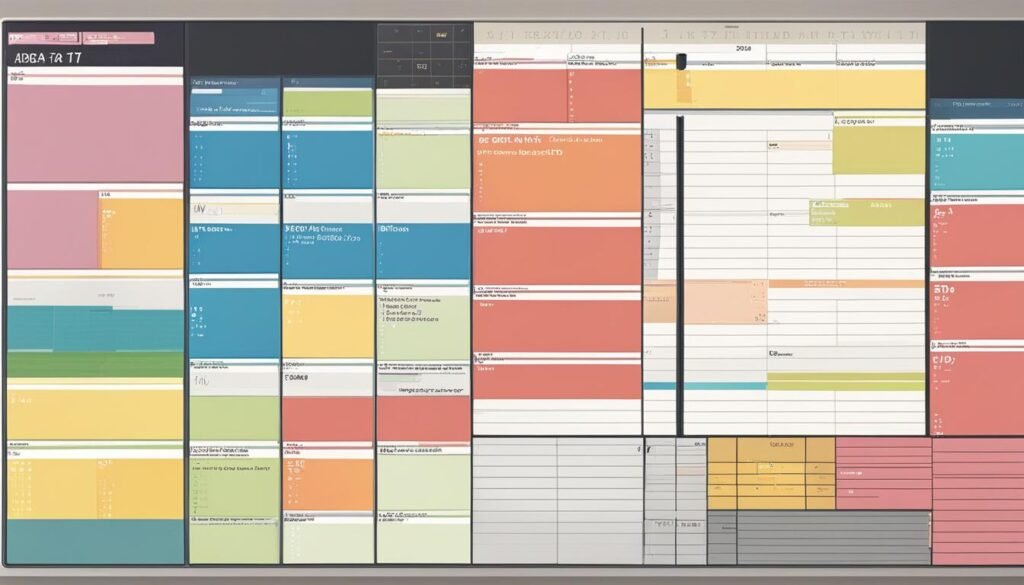Having a well-defined blog content strategy is essential for achieving success in the world of blogging.
It not only saves time but also drives more traffic to your blog. According to the Content Marketing Institute, organizations with a written content strategy are 60% more effective.
In this guide, I will outline five steps to help you craft a strong blog content strategy that will set you up for success.
Key Takeaways:
- A written blog content strategy doubles your chances of success.
- Defining clear and measurable goals is crucial for your blog’s success.
- Performing target market research helps you understand your audience better.
- Choosing the right topics and keywords is essential for driving organic traffic.
- Creating a content calendar ensures consistent publishing and organization.
Step 1: Define Your Goals
Setting clear goals is the first step in creating a successful blog content strategy.
Your goals act as a roadmap, guiding your content creation and ensuring that you are targeting the right audience with the right message.
When defining your goals, it’s important to be specific, measurable, and time-bound.
For example, instead of saying “increase blog traffic,” a more effective goal would be “increase blog traffic by 25% in the next three months.”
Simon Sinek’s TED talk emphasizes the power of having a clear “why” – the purpose behind your blog.
By understanding your goals, you can align your content strategy with your overall business objectives.
Your goals serve as the guiding force in determining the content to create, the platforms to prioritize, and the metrics to measure success.
Examples of goals for your blog could include driving foot traffic to your shop or office, increasing sales or generating leads, or educating prospects and customers.
By defining your goals at the start, you can create a blog content strategy that is laser-focused on achieving those desired outcomes.
Step 2: Perform Target Market Research
Target market research is a crucial step in crafting an effective blog content strategy.
To craft compelling content that deeply connects with your audience, it is crucial to possess a comprehensive understanding of their demographics, behaviors, and needs.
By delving into these key aspects, you can create tailored and impactful content that resonates profoundly with your target audience.
Conducting thorough market research will provide you with valuable insights to guide your content creation process.
One method to gather audience data is through surveys and interviews.
These tools allow you to directly ask your target market about their preferences, pain points, and desired solutions.
You can also use analytics tools like Google Analytics or BuzzSumo to analyze the online behavior of your audience.
By tracking metrics such as website traffic, engagement, and social media interactions, you can gain a deeper understanding of your readers’ interests and motivations.
Identifying the platforms where your target market hangs out is another essential aspect of target market research.
Determine which social media platforms, forums, or blogs your audience frequents.
This information will enable you to tailor your content distribution strategy to reach your target market effectively.

Gathering audience insights through target market research:
- Identify audience demographics, behaviors, and needs
- Conduct surveys and interviews to gather insights
- Utilize analytics tools like Google Analytics or BuzzSumo
- Determine your audience’s preferred online platforms
By performing comprehensive target market research, you can ensure that your blog content strategy aligns with the interests and desires of your audience.
This valuable knowledge will equip you with the ability to craft compelling content that deeply connects with your readers, fostering significant engagement and impact.
Step 3: Come Up with Topic Ideas and Keywords
When it comes to creating valuable blog content, topic ideas and keywords play a crucial role in attracting readers and driving organic traffic.
Keyword research is an essential step in optimizing your blog posts for search engines.
By finding keywords with high search volume and low competition, you can strategically incorporate them into your content and increase your chances of ranking well.
However, it’s important to remember that valuable content goes beyond just keywords.
To truly engage your audience, focus on addressing their needs and interests.
Consider their pain points and challenges, and aim to provide informative and insightful solutions through your blog posts.
Here are some tips for coming up with topic ideas and keywords:
- Research your target audience: Get to know your readers and what they’re looking for. Use tools like surveys, interviews, or social listening to gain insights into their interests, preferences, and questions.
- Explore trending topics: Stay up-to-date with the latest industry trends and news. This can help you identify popular topics that are relevant to your audience and can generate high engagement.
- Brainstorm creative angles: Look for unique angles and perspectives to make your content stand out. Think about how you can present information freshly and interestingly that resonates with your readers.
- Utilize keyword research tools: Use tools like Google Keyword Planner, SEMrush, or Ahrefs to discover relevant keywords related to your blog niche. Look for long-tail keywords that have a good search volume and a lower competition level.
By combining keyword research with a focus on valuable content, you can create blog posts that not only attract readers but also provide them with meaningful and informative content.

Step 4: Create a Blog Content Calendar
Organizing and planning your blog content is essential for timely publishing and maintaining an organized workflow.
Creating a blog content calendar can help you stay on track and ensure consistent delivery of high-quality posts.
With a content calendar, you can strategically schedule your blog topics, set deadlines, and allocate resources effectively.
Using tools like Airtable, Trello, or Google Calendar, you can easily create and manage your content calendar.
These platforms offer features such as customizable templates, task tracking, and collaboration options.
Consider integrating your content calendar with your social media and email marketing platforms to streamline your promotional efforts and maximize your blog’s impact.
A well-designed content calendar also allows you to visualize your content distribution over time.
You can identify any gaps or overlaps in your publishing schedule and make adjustments accordingly.
By planning, you’ll have a clear roadmap for your blog content, making it easier to focus on creating valuable and engaging posts.
Benefits of a Blog Content Calendar:
- Improved organization and workflow management
- Consistency in publishing schedule
- Efficient allocation of resources
- Opportunity for collaboration within your marketing team
- Visibility into the status of each piece of content
Remember, a content calendar is a flexible tool that allows you to adapt to changes and opportunities.
Be open to adjusting your schedule as needed to accommodate new trends, current events, or emerging topics that are relevant to your audience.
With a well-structured content calendar in place, you’ll be able to streamline your blog organization and achieve timely publishing.

Step 5: Build Amazing Content
Building amazing content is the cornerstone of a successful blog.
To engage your readers and keep them coming back for more, focus on creating high-quality, valuable, and well-researched blog posts.
One effective approach is to address your audience’s pain points and provide solutions.
By understanding their needs and challenges, you can tailor your content to provide relevant and helpful information.
Use a storytelling approach to captivate your readers and make your content more engaging.
Incorporating personal anecdotes or real-life examples can help your audience relate to your content on a deeper level.
Visual elements also play a crucial role in enhancing the user experience.
Including images, infographics, or videos can make your content more visually appealing and easier to consume.
Remember to optimize your images with alt tags and descriptive filenames to improve search engine visibility.
Key Tips for Building Amazing Content:
- Address your audience’s pain points and provide solutions
- Use a storytelling approach to captivate your readers
- Incorporate visual elements to enhance the user experience
- Regularly update and repurpose your content to keep it fresh and relevant
By consistently delivering valuable content that resonates with your audience, you can establish yourself as a trusted authority in your niche and drive more traffic to your blog.

Choosing Your Blog Name and Niche
Choosing the right blog name and niche is crucial when starting a blog.
Your blog name should reflect your content or personal brand, making it memorable for your audience. It’s like choosing a domain name for your website.
When selecting a blog niche, consider your strengths, interests, and expertise. It should be a topic area that you are knowledgeable and passionate about.
This will make it easier for you to consistently create valuable content and engage with your readers.
Remember to also consider your target audience’s needs and interests.
Aligning your blog niche with their preferences ensures that your content is relevant and valuable to them.
By catering to their needs, you can attract a loyal readership and build a community around your blog.
Why Your Blog Name Matters
Your blog name is the first thing that readers will see and remember. It’s like the face of your blog, and it creates a lasting impression. A well-chosen blog name can make your blog stand out in a crowded niche and attract the right audience.
Consider using words related to your blog’s content or your brand in your blog name. This helps readers understand what your blog is about and makes it easier for them to find you through search engines.
Choosing Your Blog Niche
When selecting your blog niche, ask yourself what topics you are passionate about and have expertise in.
This will make it easier for you to consistently create high-quality content that resonates with your audience.
Remember that your blog niche should also align with your target audience’s interests and needs.
Research what topics are trending or have a high demand in your chosen niche.
This will help you identify opportunities to differentiate your blog and provide unique value to your readers.
By focusing on a specific niche, you can establish yourself as an authority in that field and attract a loyal following.

Getting Your Blog Online
Now that you have a solid blog content strategy in place, it’s time to bring your blog online.
This section will guide you through the process of setting up your blog on a self-hosted platform using WordPress.
First, you’ll need to choose a web hosting provider that offers reliable services and excellent customer support.
I recommend Bluehost as it is a trusted and popular option among bloggers. They provide easy WordPress installation, secure servers, and affordable hosting plans.
Once you’ve selected your web hosting provider, you’ll need to choose a domain name that reflects your blog’s identity.
Your domain name is your blog’s address on the internet, so make sure it is catchy, memorable, and relevant to your niche.
After setting up your hosting plan and purchasing a domain name, you can install WordPress onto your hosting account.
Most hosting providers offer a one-click WordPress installation, making it simple and hassle-free.
Once installed, you can customize your WordPress theme, install plugins for added functionality, and start creating your blog posts.
Key Points:
- Choose a reliable web hosting provider like Bluehost for your blog.
- Select a domain name that reflects your blog’s identity.
- Install WordPress onto your hosting account.
- Customize your WordPress theme and install plugins for added functionality.
- Start creating engaging and informative blog content for your readers.
By following these steps, you’ll have your blog up and running, ready to attract and engage your target audience.
The web hosting and WordPress combination will provide you with the flexibility and control to grow your blog into a successful online platform.
What is a Blog?
A blog is a powerful online platform that allows individuals and businesses to publish and share content in an informal and conversational style.
Blogs have become increasingly popular in recent years, as they provide a flexible and accessible way to communicate with a wide audience.
Whether you’re passionate about travel, food, technology, or fashion, a blog offers the perfect medium to express your thoughts, share your experiences, and connect with like-minded individuals.
With a blog, you can publish a variety of content formats, such as articles, images, videos, and podcasts.
It’s a space where you can showcase your expertise, highlight your unique perspective, and engage with your readers.
Building a successful blog requires consistent publishing, quality content, and a clear understanding of your target audience’s interests and needs.
“Blogging is not just about publishing content, it’s about creating an online community where people can connect, share ideas, and find inspiration.” – Jane Doe
Blogs can also serve as a source of online income.
By monetizing your blog through various strategies like affiliate marketing, sponsored content, or selling digital products, you can turn your passion into a profitable business.
However, it’s important to remember that building a successful blog takes time, effort, and dedication.
Consistently providing value to your readers, promoting your content, and building relationships within your niche are key factors in achieving blogging success.
Providing Value to Your Readers
As a blogger, the most important aspect of your work is to deliver value to your readers.
Your content should answer their questions, provide solutions to their problems, and address their pain points.
By tailoring your content to meet the needs of your target audience, you can create a loyal readership that keeps coming back for more.
To provide value, focus on creating informative and engaging blog posts.
Take the time to research your topics thoroughly and provide accurate and up-to-date information.
Use examples, case studies, or quotes from experts to support your points and make your content more credible.
In addition to informative content, engaging your readers is crucial. Use storytelling techniques to captivate your audience and make your posts more relatable.
Incorporate personal experiences or anecdotes that your readers can resonate with.
By doing so, you can create an emotional connection with your audience and keep them engaged throughout your blog.
Demonstrate your expertise
One way to provide value to your readers is by demonstrating your expertise in your niche.
Share your knowledge, insights, and experiences to establish yourself as an authority in your field.
Show your readers that you are knowledgeable and passionate about your topic, and they will trust your content and rely on you for guidance.
Remember, your blog is not just about sharing information; it’s about helping your readers achieve their goals. Focus on solving their problems and addressing their needs, and your blog will become a valuable resource for them.
- Research your audience: Understand who your target audience is and what they are looking for.
- Create valuable content: Provide information, insights, and solutions that are relevant and helpful to your readers.
- Engage your readers: Use storytelling techniques, personal experiences, and relatable examples to keep your readers engaged.
- Demonstrate your expertise: Share your knowledge and insights to establish yourself as an authority in your niche.
By consistently delivering value to your readers, you can build a loyal and engaged readership.
Keep in mind that providing value should be the foundation of your blogging strategy.
Stay connected with your audience, listen to their feedback, and continue to evolve your content to meet their changing needs.
Remember, your success as a blogger depends on the value you bring to your readers.
Embracing Mistakes and Taking Risks
As a blogger, I’ve learned that making mistakes is an inevitable part of the journey.
Instead of fearing them, I’ve come to embrace them as valuable learning opportunities that have propelled my growth.
Each mistake has taught me a valuable lesson and helped me refine my strategies.
It’s through these experiences that I’ve discovered the importance of taking risks and stepping out of my comfort zone.
One of the greatest rewards of blogging is the ability to experiment and try new things.
I encourage you to stay curious and open-minded, always willing to explore innovative approaches.
Keep a notebook where you can jot down ideas, experiments, and lessons learned.
Reflect on your progress regularly and be willing to adjust your strategies as needed.
It’s through this continuous process of trial and error that you’ll uncover breakthroughs and find success.
“The only way to truly fail is to never try in the first place.” – Anonymous
Remember that taking calculated risks is essential for growth as a blogger.
It’s easy to fall into a routine and stick to what feels comfortable, but by pushing boundaries and taking risks, you have the opportunity to discover new avenues of success.
Whether it’s trying out a new content format, collaborating with other bloggers, or exploring different marketing strategies, taking risks can lead to exciting breakthroughs and unexpected achievements.
Learning from Mistakes and Growing
Throughout my blogging journey, I’ve encountered numerous setbacks and failures.
However, I’ve come to realize that mistakes are not failures but stepping stones to success.
Each misstep has provided me with valuable insights, teaching me what works and what doesn’t.
By analyzing and learning from these mistakes, I’ve been able to refine my approach, resulting in improved content, increased engagement, and enhanced growth.
Don’t be discouraged by your mistakes; instead, use them as opportunities for growth. Embrace the lessons they offer and apply them to future endeavors.
Remember, even the most successful bloggers have faced setbacks along the way. It’s how we choose to approach these setbacks that ultimately determines our success.
So, don’t shy away from taking risks, learning from mistakes, and embracing the journey of growth and self-improvement.
Conclusion
To achieve success in the world of blogging, it is crucial to develop a well-defined blog business strategy and stay focused on your goals.
By following the five steps outlined in this guide, you can craft a strong blog content strategy that will drive your blogging efforts forward.
Start by defining your objectives, ensuring they are specific, measurable, and time-bound.
Next, conduct thorough target market research to understand your audience and their needs. This will help you generate topic ideas and keywords that resonate with your readers.
With a content calendar in place, you can stay organized and consistently publish valuable content.
Remember to focus on building amazing content that addresses your audience’s pain points and engages them through storytelling and visual elements.
Lastly, treat your blog as a business from the beginning. Provide value to your readers, embrace mistakes, and take calculated risks to grow and achieve your blogging goals.
With dedication and a well-executed blog business strategy, you can set yourself up for success in the dynamic world of blogging.
FAQ
What is a blog content strategy?
A blog content strategy is a written plan that outlines the goals, target audience, topic ideas, content calendar, and methods for creating and promoting blog content. It helps save time, drive more traffic, and increase the chances of blogging success.
Why is a blog content strategy important?
Having a written blog content strategy doubles your chances of success. According to the Content Marketing Institute, organizations with a written content strategy are 60% more effective. It provides a clear direction for your blog, ensures consistency, and helps you create valuable content that resonates with your audience.
How do I define my goals for my blog content strategy?
Define specific, measurable, and time-bound goals for your blog. Consider what you want to achieve, such as driving foot traffic, increasing sales, generating leads, or educating prospects and customers.
Your goals should align with the purpose and target audience of your blog.
How can target market research help with my blog content strategy?
Target market research helps you understand your audience and their motivations. Identify where your audience hangs out online, such as social media platforms, blogs, or forums.
Discover their biggest pain points or challenges at work and the type of content they enjoy reading. This research will provide valuable insights to enhance your content creation and enable you to deliver high-quality content that effectively addresses their specific needs.
How important is keyword research in a blog content strategy?
Keyword research is essential for ranking well in search engines and driving organic traffic. Find keywords with high search volume and low competition to target in your blog content.
However, don’t solely rely on keywords. Consider your target audience’s interests and pain points when generating topic ideas. Focus on providing valuable and informative content that addresses their needs.
How can I stay organized with my blog content strategy?
Use a content calendar to plan and schedule your blog content.
Tools like Airtable, Trello, or Google Calendar can help you stay organized. Include social sharing and email marketing integration to maximize the impact of each blog post.
A content calendar also enables collaboration within your marketing team and provides visibility into the status of each piece of content.
How do I create amazing content for my blog?
Focus on creating in-depth, valuable, and well-researched content that addresses your audience’s pain points.
Use a storytelling approach to captivate your readers and make your content more engaging. Incorporate visual elements, such as images or videos, to enhance the overall user experience.
Regularly update and repurpose your existing content to keep it fresh and relevant.
How do I choose a blog name and niche?
When choosing a blog name, consider using words that reflect your content or personal brand.
Your blog’s niche should be a topic area that you are knowledgeable and passionate about.
Think about your strengths, interests, and expertise when selecting a niche. Consider your target audience’s needs and interests to ensure your blog is valuable to them.
What do I need to get my blog online?
To have full control and ownership of your blog, opt for a self-hosted platform like WordPress.
Choose a reliable web hosting provider like Bluehost to ensure your blog is accessible and secure.
Set up your blog by selecting a hosting plan and a domain name that reflects your blog’s identity.
The right combination of web hosting and blogging platform will provide a solid foundation for your blog.
What is a blog and how does it work?
A blog is a regularly updated website that focuses on sharing content in an informal or conversational style.
The goal of a blog is to attract readers and generate online income. Bloggers can create and publish content on various topics, ranging from travel and food to technology and fashion.
Blogging offers a flexible and accessible way to launch an online business and earn money from anywhere in the world.
How can I provide value to my readers?
Successful blogging revolves around delivering value to your readers. Answer their questions, provide solutions to their problems, and address their pain points.
Tailor your content to meet the needs of your target audience. Focus on creating informative and engaging blog posts that resonate with your readers.
Building a loyal readership requires consistently delivering valuable content that keeps them coming back for more.
How should I approach mistakes and risks in blogging?
Making mistakes is part of the blogging journey. Embrace them as learning opportunities and continue to grow. Stay curious and don’t be afraid to try new things.
Keep a notebook to jot down ideas, experiments, and lessons learned. Reflect on your progress regularly and adjust your strategies as needed.
Taking calculated risks can lead to breakthroughs and innovative approaches in your blogging career.
What are the steps for crafting a strong blog content strategy?
To craft a strong blog content strategy, follow these five steps: define your goals, perform target market research, come up with topic ideas and keywords, create a blog content calendar, and build amazing content.
These steps will help you save time, drive more traffic, and increase your chances of blogging success.
